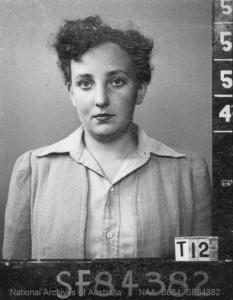These young women have just embarked on an adventure of a lifetime. The wait is over. The papers are signed. They’ve taken the plunge and done it. These women have enlisted for service in the Second World War.
Into the unknown
The photographs seen here are among thousands which capture the moment at which women’s lives were being transformed. Before the war, female employment opportunities had been limited to areas like retail, clerical, domestic service, nursing, teaching or farm labour. Even then, most women would have expected that paid employment would have been a short interlude before marriage.
Enlisting must have been an exciting, confusing and perhaps, at times, rather boring experience for many. A lot of standing around waiting for your turn. Potential enlistees arrived at a recruiting depot, filled in forms, underwent a medical and, if they passed that, had their photograph taken, swore an oath, and were in.
Candid camera
We see women’s expressions captured in a fleeting moment of transition from the old familiar life to the new and unknown. Many would never have travelled very much or lived away from home before, and some might even have been enlisting against their parents’ wishes.
The photographs are vivid and varied. Each image compels our attention afresh. Each invites us to imaginatively enter the life of that person to wonder what brought them to that moment and what might happen next.
Few women at that time would have had their photograph taken outside a family or domestic setting. They might have had a studio or street photograph made as gift for their relatives, or been photographed on holiday or at a wedding. With overseas travel much less common, relatively few women would have had a passport photo taken.
So this was a new experience. Some seem to be trying to hide their emotions from the gaze of the male photographer. Some seem anxious, others relaxed. A few have sparkles in their eyes and smiles on their faces, ready for anything that their new lives might throw at them.
Wanted urgently
After the war broke out in 1939, women began lobbying for the opportunity to enter the army, navy and air force. Over time it became obvious that their labour could be used to release men for frontline service, and a women’s unit was formed within each of those services.
Male commentators had been worried that by entering the services women would compromise their feminine abilities as future home-makers. However, this was an 'all in' war effort. Now, for instance, a recruiting poster claimed that '100s of Australia's keenest women' were wanted urgently for anti-aircraft defence. Across the army, navy and air force, women served in dozens of different trades and occupations, and not just in traditional roles, such as clerks and cooks. They also worked, for instance, as drivers, signallers, mechanics, photographers, wireless operators and laboratory assistants. Some 385 members of the Australian Women’s Army Service were posted to New Guinea in 1945.
Faces revealed
The subjects of the photographs would never have seen the images. They were added to their enlistment papers and, over time, came to comprise a record of their service.
Those records are now held by the National Archives.
We are undertaking a mass digitisation project covering all the service records of men and women who served in the army and air force.
Navy records, which do not include identification photographs, have already been digitised. Our digitisation project is revealing enlistment photographs of women who served in the Women's Auxiliary Australian Air Force, formed in March 1941, and the Australian Women’s Army Service, formed in August 1941. Together these add up to over 43,000 women. Most (although not all) files include photographs.
Could there be a photograph of your relative in our collection?
We can help you find out. Please complete our enquiry form and we will get back to you.
















